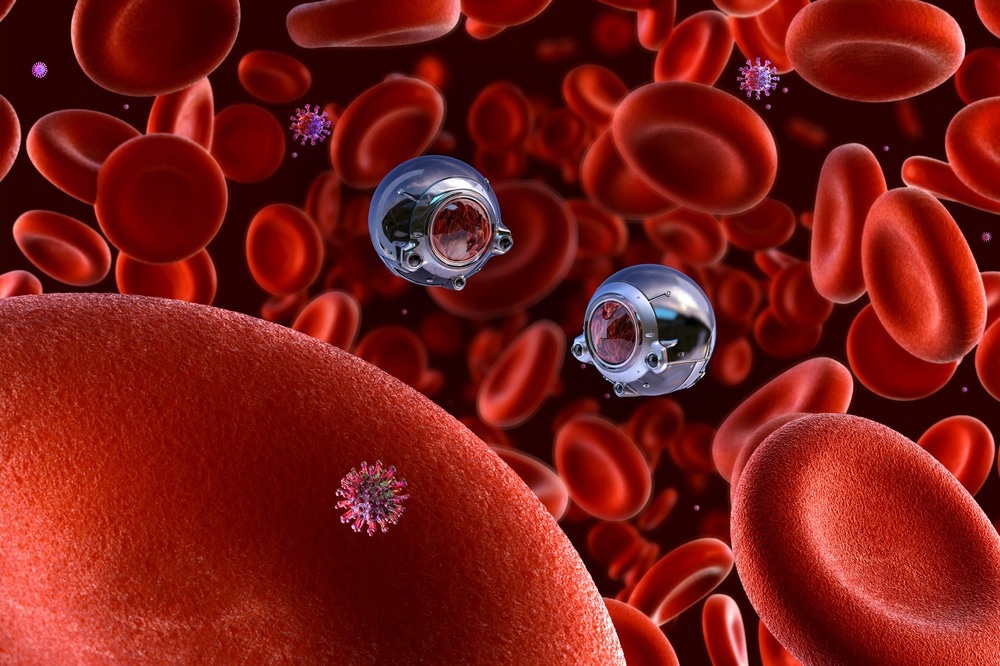Micro/nanorobots have been extensively explored for biomedical applications because of their efficiency in targeted therapy and their accuracy in performing local diagnosis. Magnetic micro/nanorobots are considered fuel-free tools with a non-destructive penetrative ability through biological tissues, as a magnetic field can control the movement of micro/nanorobots within a living system.

Study: Magnetic Micro/Nanorobots: A New Age in Biomedicines. Image Credit: Corona Borealis Studio/Shutterstock.com
In addition to integrating micro/nanorobots, remote control and imaging are essential for their in vivo biomedical applications. An article published in Advanced Intelligent Systems discussed the fabrication methods and driving mechanisms of micro/nanorobots controlled by a magnetic field.
Furthermore, this review has highlighted the application of magnetic micro/nanorobots as carriers of drugs, live cells, and bioagents, as well as a surgical tool for sample collection, biofilm degradation, and ophthalmic surgery.
Micro/Nanorobots and Their Driving Forces
In recent years, micro/nanorobots have advanced rapidly. Most existing micro/nanorobots perform commands via externally controlled self-propulsion mechanisms. Unlike large micro/nanorobots that move by inertia, their smaller counterparts that move in an environment of low-Reynolds-number fluids must be continuously powered.
Such environments are dominated by viscous forces, whereas inertial forces remain negligible; thus, an object moves slowly. However, because of their small dimensions, loading engines or batteries onto micro/nanorobots is challenging. Consequently, researchers have focused on the driving forces of micro/nanorobots.
Micro/nanorobots are classified as magnetically driven, chemically driven, ultrasound-driven, light-driven, or electrically driven, depending on the power source used. Chemically powered micro/nanorobots move faster than those powered by other methods; however, they lack directionality. Furthermore, the chemical fuels required, including hydrogen peroxide, hydrazine, sodium hydroxide, and hydrochloric acid, are toxic.
Light-driven micro/nanorobots require light sources of high intensity and hydrogen peroxide, which can impact biocompatibility. Although ultrasound-driven micro/nanorobots are biocompatible, it is difficult to control their direction. Electrically powered micro/nanorobots show great promise for fuel-free transport. However, their biological applications are limited and poorly demonstrated.
Biomedical Applications of Micro/nanorobot
The precise and efficient delivery of therapeutic drugs to target sites, particularly to locations in the body that are concealed and difficult to reach, is a significant challenge for passive drug delivery systems. This problem can be solved using an active and intelligent drug delivery system composed of micro/nanorobots propelled by an external magnetic field.
Micro/nanorobots can carry a variety of cargo, including drugs, biologics, living cells, and inorganic therapeutics. The carrier can be driven to a specific position by a magnetic field, and the loaded therapeutic drug can be released by changing the environment or by applying an external field. A simple and universal method for manipulating droplets using a magnetically driven robot was reported.
Various medical tools cannot pass through deep tissues, limiting micrometers or nanoscale surgery. Due to their small size, micro/nanorobots can access areas where blades and catheters cannot. Furthermore, they reduce the risk of infection while improving recovery time, surgical precision, and control.
A magnetic nanorobot composed of carbon nano-coils guided by a rotating electromagnetic field can precisely localize individual cells and penetrate the cell membranes. Surface-enhanced Raman scattering biosensing signals from the cellular plasma and nuclei were collected using an externally deposited gold nanofilm. This magnetic nanorobot has a wide range of applications as an integrated therapeutic platform for precision medicine.
Future Prospects of Micro/Nanorobots
New preparation methods are required for in vivo biomedical applications of micro/nanorobots to optimize and functionalize their structures and accomplish cost-effective and large-scale preparation of different systems.
Micro/nanorobot materials must meet standards for practical biomedical and environmental applications, improve biodegradability and biocompatibility, and reduce toxicity in medical and biological environments.
Swarms or collective robot behavior can effectively perform tasks in complex biological environments which individual micro/nanorobots cannot accomplish and improve work efficiency by harnessing biological imaging technology. Although there is a long way to go before micro/nanorobots can be used on a large scale in clinical settings, their use in precision medicine is still substantial.
Conclusion
In summary, substantial advances have been made in the past decade in designing and fabricating micro/nanorobots with various functions. These artificial micro/nanorobots can transport drugs, bioagents, and living cells in living systems. They also serve as surgical tools for ophthalmic surgery, sample collection, and biofilm degradation, as well as imaging tools for in vitro and in vivo imaging using light, sound, magnetic fields, and other methods.
Additional research on the design of robots with high efficiency, low cost, scalability, and environmentally friendly microfabrication technologies is required to empower micro/nanorobots in biomedical applications.
Reference
Liu, D., et al. (2022), Magnetic Micro/Nanorobots: A New Age in Biomedicines. Advanced Intelligent Systems. https://doi.org/10.1002/aisy.202200208
Disclaimer: The views expressed here are those of the author expressed in their private capacity and do not necessarily represent the views of AZoM.com Limited T/A AZoNetwork the owner and operator of this website. This disclaimer forms part of the Terms and conditions of use of this website.